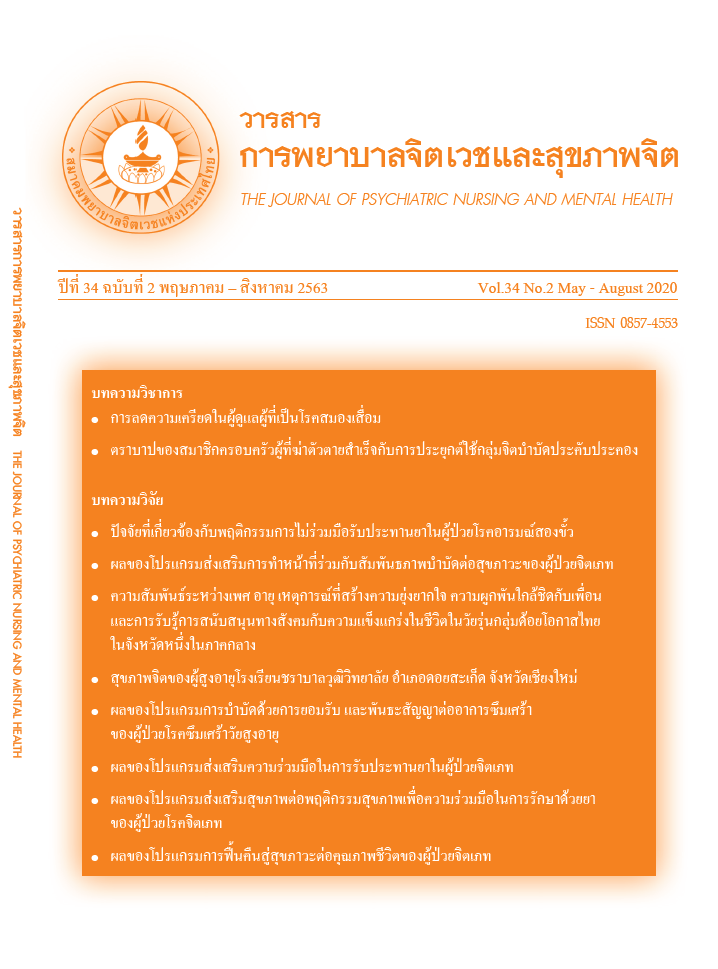ตราบาปของสมาชิกครอบครัวผู้ที่ฆ่าตัวตายสำเร็จกับการประยุกต์ใช้กลุ่มจิตบำบัดประคับประคอง
Main Article Content
บทคัดย่อ
บทคัดย่อ
การฆ่าตัวตายไม่เพียงส่งผลต่อผู้ฆ่าตัวตาย แต่ยังส่งผลต่อสมาชิกครอบครัว เพื่อนสนิท และ บุคคลอันเป็นที่รักด้วย ทุกครั้งที่มีการฆ่าตัวตาย สำเร็จ สมาชิกครอบครัวของผู้ที่ฆ่าตัวตายสำเร็จ อาจรู้สึกอับอาย รู้สึกแปลกแยกจากสังคม และ เกิดความรู้สึกที่เจ็บปวด และในบางรายไม่ สามารถตระหนักถึงความรู้สึกของตนเองได้ เป็น ความเจ็บปวดที่อาจสร้างตราบาปให้กับสมาชิก ครอบครัวของผู้ที่ฆ่าตัวตายสำเร็จได้ ในที่สุด สมาชิกครอบครัวของผู้ที่ฆ่าตัวตายสำเร็จอาจ ใช้สารเสพติดหรืออาจกระทำการฆ่าตัวตายได้ การใช้กลุ่มจิตบำบัดประคับประคองเพื่อลดตราบาปจึงมีความสำคัญ เนื่องจากจะช่วยให้ สมาชิกกลุ่มเกิดความรู้สึก ปลอดภัย มั่นคง เป็น ที่ยอมรับว่าเขาจะสามารถพูดถึงความรู้สึกได้ และได้ติดต่อสื่อสารกับผู้อื่นที่มีการสูญเสียบุคคล อันเป็นที่รักจากการฆ่าตัวตาย โดยองค์ประกอบ สำคัญของการบำบัดคือ ความรู้สึกเป็นสากล การผูกพันจิตใจต่อกัน และการบ่มเพาะความหวัง บทความนี้มีวัตถุประสงค์เพื่อนำเสนอถึงผลกระทบ ของตราบาปในกลุ่มญาติผู้สูญเสีย ความสำคัญของ กลุ่มจิตบำบัดแบบประคับประคองในการช่วยลด ตราบาป และบทบาทของพยาบาลจิตเวชในการ เป็นผู้บำบัด เพื่อลดขนาดความรุนแรงของปัญหา ด้านสุขภาพจิตและผลกระทบที่เกิดขึ้นจากการ ฆ่าตัวตาย
Article Details
บทความที่ได้รับการตีพิมพ์แล้ว เป็นลิขสิทธิ์ของสมาคมพยาบาลจิตเวชแห่งประเทศไทย
เอกสารอ้างอิง
กรมสุขภาพจิต กระทรวงสาธารณสุข. (2561). รายงานอัตราการฆ่าตัวตาย (รายต่อแสน ประชากร). สืบค้น จาก https://www.dmh. go.th/report/suicide/stat_prov.asp.
เฉลิมพรรณ์ เมฆลอย, กชพงศ์ สารการ และ อัญชลิกา ภูมิรัชปัญญา. (2558). ผลของกลุ่ม จิตบำบัดต่อภาวะซึมเศร้าและตราบาปใน สมาชิกครอบครัวผู้ที่ฆ่าตัวตายสำเร็จ. วารสารสุขภาพจิตแห่งประเทศไทย, 23(2), 125-134.
เฉลิมพรรณ์ เมฆลอย, ปราการ ถมยางกูร และสุระ คุณคงคาพันธุ์. (2552). การเยียวยาผู้ได้รับ ผลกระทบผู้ใกล้ชิดฆ่าตัวตายสำเร็จ. เชียงราย: โรงพยาบาลแม่สาย.
ชูศรี เกิดพงษ์บุญโชติ, เบญจพร ปัญญายง และ ชูชาติ วงศ์อนุชิต. (2558). การรับรู้ตราบาป ของผู้ป่วยจิตเวช. วารสารสุขภาพจิตแห่ง ประเทศไทย, 23(1), 25-37.
ปราการ ถมยางกูร, เฉลิมพรรณ์ เมฆลอย, อัปษรศรี ธนไพศาล และอรพิน ยอดกลาง (2552). คู่มือกลุ่มบำบัดครอบครัวที่มีสมาชิกใน ครอบครัวฆ่าตัวตายสำเร็จ. กรุงเทพ: มูลนิธิ เครือข่ายครอบครัว.
ภัทราภรณ์ ทุ่งปันคำ. (2557). กลุ่มจิตบำบัดสำหรับ บุคลากรทางสุขภาพ : แนวคิดและการ ประยุกต์ใช้. เชียงใหม่: คณะพยาบาลศาสตร์ มหาวิทยาลัยเชียงใหม่.
สภาการพยาบาล. (2552). ขอบเขตและสมรรถนะ ผู้ปฏิบัติการพยาบาลขั้นสูง. เข้าถึงเมื่อ 1 มกราคม 2553, จาก https://www.tnmc. or.th/images/userfiles/files/H014.pdf.
สุจิตรา วรสิงห์. (2557). ปัจจัยที่สัมพันธ์กับการรับรู้ ตราบาปในผู้ป่วยโรคจิตเภท. วิทยานิพนธ์ พยาบาลศาสตรมหาบัณฑิต, สาขาวิชา การพยาบาลสุขภาพจิตและจิตเวช คณะ พยาบาลศาสตร์, มหาวิทยาลัยบูรพา.
อภิชัย มงคล และคณะ. (2550). รายงานการ ประเมินผลโครงการป้องกันและช่วยเหลือ ผู้ที่มีภาวะซึมเศร้าและเสี่ยงต่อการฆ่าตัวตาย ปีงบประมาณ พ.ศ. 2550 กรมสุขภาพจิต. นนทบุรี: กระทรวงสาธารณสุข.
อรพิน ยอดกลาง, ปราการ ถมยางกูร, ทวี ตั้งเสรี, สุพิน พิมพ์เสน, เฉลิมพรรณ์ เมฆลอย, สมพร รุ่งเรืองกลกิจ และคณะ. (2552). คู่มือประกอบการอบรมโครงการพัฒนาต้นแบบการจัดตั้งกลุ่มญาติผู้สูญเสีย จากการที่สมาชิกในครอบครัวฆ่าตัวตาย สำเร็จ. ขอนแก่น: โรงพยาบาลจิตเวช ขอนแก่นราชนครินทร์
Andriessen, K., Krysinska, K., & Grad, O. T. (Eds.). (2017). Postvention in Action: The International Handbook of Suicide Bereavement Support. Boston: Hogrefe Publishing.
Asare-Doku, W., Osafo, J., & Akotia, C. S. (2017). The experiences of attempt survivor families and how they cope after a suicide attempt in Ghana: a qualitative study. BMC Psychiatry, 17, 178. doi 10.1186/s12888- 017-1336-9.
Cerel, J., McIntosh, J. L., Neimeyer, R.A., Maple, M., Marshall, D. (2014). The continuum of “survivorship”: definitional issues in the aftermath of suicide. Suicide Life Threat Behavior, 44(6), 591-600. doi: 10.1111sltb. 12093.
Constantino, R. E., Sekula, L. K., & Rubinstein, E. N. (2001). Group intervention for widowed survivors of suicide. Suicide Life Threat Behavior, 31(4), 428-441.
Corrigan, P. W., Sheehan, L., Al-Khouja, M. A., Lewy, S., Major, D. R., Mead, J., … Weber, S. (2018). Insight into the stigma of suicide loss survivors: Factor analyses of family stereotypes, prejudices, and discrimina-tions. Archives of Suicide Research, 22(1), 57-66.
Drapeau, C.W. & McIntosh, J. L. (2016). U.S.A. suicide: 2015 Official final data [Data File]. Retrieved January 16, 2016 from, http://www.suicidology.org/Portals/14/ docs/Resources/FactSheets/2015/2015 datapgsv1.p df?ver=2017-01-02-220151- 870.
Feigelman, B., & Feigelman, W. (2011). Suicide survivor support groups: comings and goings, part I. Illness, Crises & Loss, 19(1), 57-71.
Frey, L. M. (2015). Mental health among suicide attempt survivors: The roles of stigma, self-disclosure, and family reactions (Doctoral dissertation). University of Kentucky, U.S.A.
Hill, N. T. M., Robinson, J., Pirkis, J., Andriessen, K., Krysinska, K., Payne, A., … Lampit, A. (2020). Association of suicidal behavior with exposure to suicide and suicide attempt: A systematic review and multilevel meta-analysis. PLoS Medicine, 17(3), e1003074. doi: 10.1371/journal.pmed.1003074.
Keller, S., McNeill, V., Honea, J., & Miller, L. P. (2019). A look at culture and stigma of suicide: Textual analysis of community theatre performances. International Journal of Environmental Research and Public Health, 16(3), 352. doi.org/10.3390/ ijerph16030352.
Knaak, S., Modgill, G., & Patten, S. (2014). Key ingredients of anti-stigma programs for health care providers: A data synthesis of evaluative studies. Canadian Journal of Psychiatry, 59(10), S19-26. doi: 10.1177/ 070674371405901s06.
Maple, M., Cerel, J., Jordan, J. R., & McKay, K. (2014). Uncovering and identifying the missing voices in suicide bereavement. Suicidology Online, 5(1), 1-12.
O’Neill, S. M., & Kueppenbender, K. (2012). Suicide in group therapy: trauma and possibility. International Journal of Group Psychotherapy, 62(4), 586-611. doi.org/ 10.1521/ijgp.2012.62.4.586.
Pitman, A. L., Osborn, D. P. J., Rantell, K., & King, M. B. (2016). The stigma perceived by people bereaved by suicide and other sudden deaths: A cross-sectional UK study of 3432 bereaved adults. Journal of Psychosomatic Research, 87, 22–29 doi. org/10.1016/j.jpsychores.2016.05.009.
Pitman, A. L., Stevensonc, F., Osborna, D. P. J., & King, M. B. (2018). The stigma associated with bereavement by suicide and other sudden deaths: A qualitative interview study. Social Science & Medicine, 198, 121–129.
Pompili, M., Shrisvastava, A., Serafini, G., Innamorati, M. Milelli, M. Erbuta, D., … Girardi, P. (2013). Bereavement after the suicide of a significant other. Indian Journal of Psychiatry, 55(3), 256-263.
Scocco, P., Preti, A., Totaro, S., Corrigan, P. W., Castriotta, C., & SOPROXI Team (2019). Stigma, grief and depressive symptoms in help-seeking people bereaved through suicide. Journal of affective disorders, 244, 223–230. doi.org/10.1016/j.jad.2018.10.098
Scocco, P., Preti, A., Totaro, S., Ferrari, A., & Toffl, E. (2017). Stigma and psychological distress in suicide survivors. Journal of Psychosomatic Research, 94, 39-46.
Spino, E., Kameg, K. M., Cline, T. W., Terhorst, L., Mitchell, A. M. (2016). Impact of social support on symptoms of depression and loneliness in survivors bereaved by suicide. Archives of Psychiatric Nursing, 30, 602–606.
Stuart, H., Arboleda-Flo´rez, J., & Santorius, N. (2012). Paradigms lost: Fighting stigma and the lessons learned. New York: Oxford University Press.
World Health Organization (WHO). (2017). Suicide data. Retrieved May 5, 2019 from http//www: who.int/mental_health/ prevention/suicide/suicideprevent/en/.
Wright, M. S. (2017). Group interventions for survivors of suicide: A qualitative study (Doctoral dissertation). Alliant International University. U.S.A.
Yalom, I. D., & Leszcz, M. (2005). The theory and practice of group psychotherapy (5thed.). New York: Basic Books.
Young, I. T., Iglewicz, A., Glorioso, D., Lanouette, N., Seay, K., Ilapakurti, M., et al. (2012). Suicide bereavement and complicated grief. Dialogues in Clinical Neuroscience, 14, 177-186.


